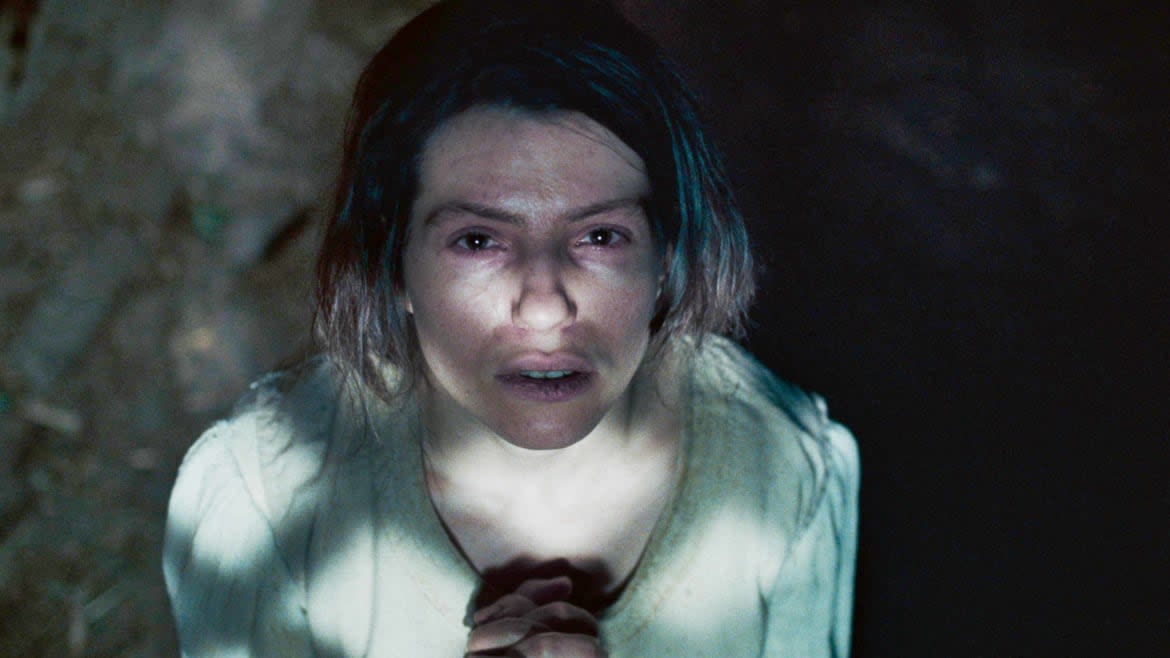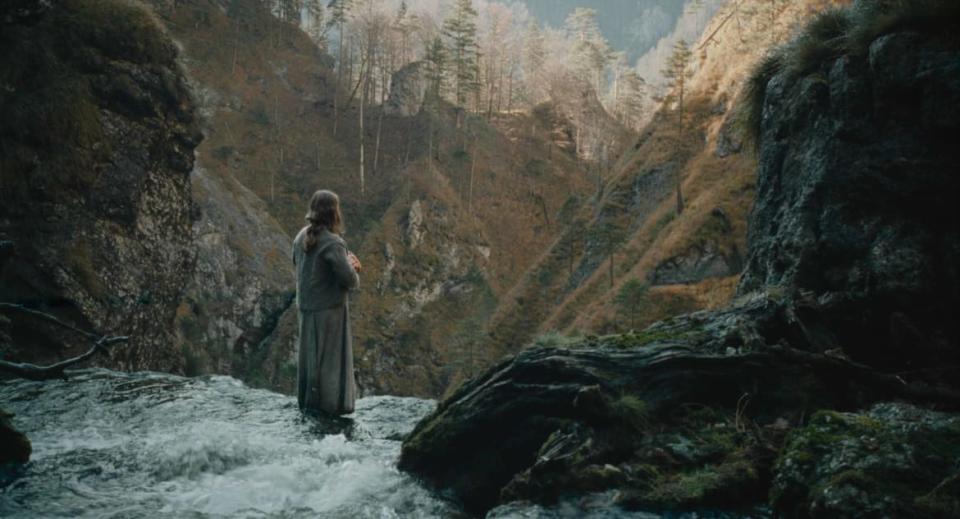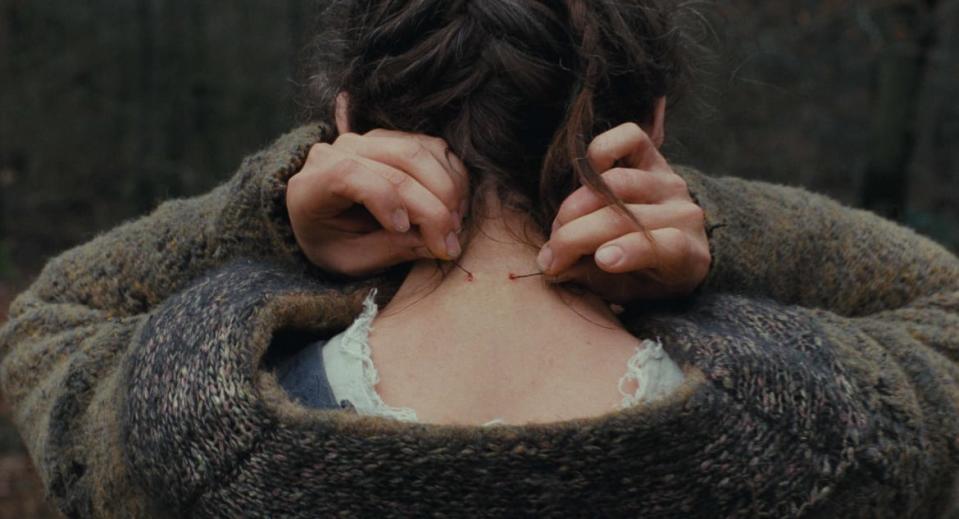‘The Devil’s Bath’ Is Unbearably Despairing—Which Is Why You Should Watch

Movies don’t come much more despairing than The Devil’s Bath. Premiering in theaters before its release June 28 on Shudder, the film is a period piece from Goodnight Mommy writers/directors Veronika Franz and Severin Fiala that offers a harrowing view of the grim realities of women’s life in 18th-century rural Europea. A sorrowful saga about a young wife’s descent into desolation and derangement, this slow-burner of a horror drama offers few respites from its literal and figurative darkness. Nonetheless, it’s a fiery sermon of despondency and damnation, as well as a memorable nightmare of marriage, motherhood, and madness.
In upper Austria in 1750, a woman plucks up her crying baby and walks him to the top of a waterfall. There, with a stern expression and little fanfare, she drops the tyke to its death, after which she crosses herself and visits the nearby prison to announce, “I’ve committed a crime.” For this murder, her toes and fingers are severed and her head is removed from her shoulders and placed in a cage to rest, forever, beside her decapitated body, which sits on a chair in a three-columned woodlands site as a reminder to all about the consequences of sin.
Shortly thereafter, Agnes (Anja Plaschg) packages up her collection of dead bugs and, with her mother and brother’s assistance, drags a cart with a dowry (of a chicken) to her wedding to Wolf (David Scheid). Upon arriving at the festivities, Agnes surfs a crowd of well-wishers as Wolf tries to take her hand, and the strangeness of this custom is offset by the auspicious mood it conjures. That atmosphere is not to last, alas. Though Agnes believed that they’d be staying with Wolf’s mother Gänglin (Maria Hofstätter), he reveals to her that he’s purchased a nearby hillside house for them. Since it boasts space for a shrine and a sizable bedchamber, she gladly acquiesces to these circumstances (not that she has a choice). At a bonfire later that evening, she’s handed a severed finger by her brother as a gift of good luck for having a child—a gesture that’s countered by the sight of Wolf drunkenly coming on to a local man.

The Devil’s Bath concentrates on Agnes as she endeavors to acclimate to her new environs, her each attempt more futile than her last. In bed on her wedding night, Wolf has her turn her back to him and vigorously strives to arouse himself, only to fail and pass out. This is more effort than he’ll subsequently show in the lovemaking department, thereby denying Agnes the pregnancy that is her chief duty in this union, community, and world. When she wakes on her first morning as a wife and finds her spouse missing, Agnes ventures to the lake where Wolf and his clan are fishing. Intent on making herself useful in whatever way possible, Agnes chips in, but her work is criticized by her mother-in-law and she receives no satisfaction from her toil. A later stab at solo fishing goes even worse, earning reprimands from Wolf, who—along with his mom—views her as incapable and, it’s suggested, a bit daft.
Agnes, however, isn’t slow-witted so much as severely depressed, and that condition mounts once she discovers a hatch in the floor of the church and ventures inside to discover a shrine that she soon embraces as her own. At every turn, Agnes bristles at her situation. Following an episode in which Gänglin tells her that she should hang her pots instead of stacking them, Agnes asks Wolf, “Will she come every day?” Her dereliction of household duties rankles Wolf and Gänglin, who wonder how she spends her time. In fact, she’s doing all manner of increasingly unhinged things, from spraying milk directly from her goat’s udder into her mouth (and then mimicking the animal), to rubbing her tongue raw with a branch, to snatching an infant that she stumbles upon in the woods and bringing it home to present to her husband.
‘Interview With the Vampire’: Inside the Horrific Episode That Changes Everything
The Devil’s Bath’s prologue foreshadows its finale, although that doesn’t mean that Franz and Fiala don’t deliver unnerving surprises. Still, the duo’s latest is less a shocking thriller in the vein of their breakthrough hit than a gradual plunge into a pit of anguish and insanity. Left with no agency, no options, and no purpose except dreary everlasting servitude, Agnes begins to crack, consumed by disturbing religious visions and desires, and compelled to utter whispered prayers as she traipses through the forest with nothing illuminating her path by the moon and a torch. She’s a wandering specter of the night, and one of her favorite destinations is the beheaded woman, whose face—like the dead fish heads that hang from hooks in her kitchen—she stares at with a mixture of compassion and understanding.

Agnes struggles mightily to alleviate her misery, and for her trouble earns additional pain and suffering, culminating with a trip to a healer who threads a long hair through the skin on the back of her neck and tells her to pull it back and forth to drain the poison within. Unsurprisingly, this is not the remedy she needs, nor are pious hallucinations or doses of fatal toxins. From that point forward, The Devil’s Bath tumbles down, down, down into an abyss from which there is no escape. If suicide results in eternal residence in Hell, then Agnes comes to understands that there’s merely one way to permanently save herself and her soul, and it involves an act of unthinkable cruelty that the directors stage with a bitter coldness in tune with their frosty woodlands milieu and the unsentimental community which calls it home.
As if the conclusion of The Devil’s Bath weren’t harrowing enough, the film closes with a dedication to the real-life figures who inspired this bleak tale—a reminder that such horrors are far from the stuff of fantasy. What’s ultimately most memorable about Franz and Fiala’s latest, however, is Plaschg’s stunning lead performance. Exuding a degree of escalating melancholy that eventually tips over into full-bore psychosis, she proves a disquieting vision of womanhood under siege, and the inevitable consequences of affording individuals a future without comfort, warmth, or hope.
Get the Daily Beast's biggest scoops and scandals delivered right to your inbox. Sign up now.
Stay informed and gain unlimited access to the Daily Beast's unmatched reporting. Subscribe now.


